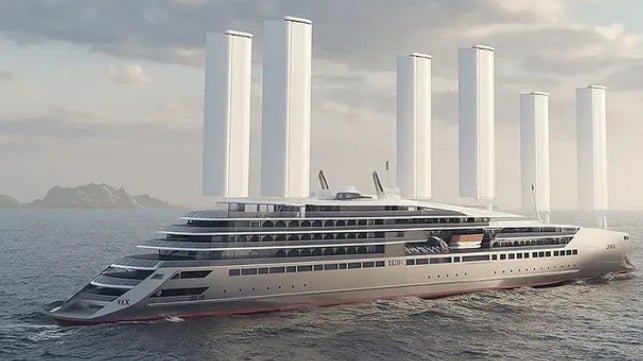Carbon Capture, Fuel Cells, and Wind Propulsion for Net-Zero Cruise Ship

A partnership consisting of GTT and Bloom Energy is working together with France’s Ponant Explorations Group to combine fuel cells and marine carbon capture as part of a project to achieve the first net-zero cruise ship. The project, which was first revealed last year, reports that GTT, known for its containment systems and Bloom Energy will lead a joint innovation project to develop an integrated energy system to cover the vessel’s energy needs related to onboard consumption.
“This partnership is a key milestone in developing innovative and efficient ways to capture CO2 and embodies our commitment to finding new solutions to decarbonizing the maritime industry,” said Mathieu Petiteau, Newbuilding and R&D Director of Ponant Explorations Group. “It also marks another step forward for our Swap2Zero vessel project, co-funded by the European Union Innovation Fund and France 2030.”
The Swap2Zero Project was unveiled in 2023 with the goal of developing the first transoceanic ship aimed at carbon neutrality. The concept, which is being designed by firms LMG Marin and Stirling Design, envisions an 181-meter (594-foot) cruise ship with approximately 100 passenger cabins that would use 50 percent wind energy. They project a speed of 10 knots and total autonomy for an endurance of up to 30 days. It would reduce greenhouse gas emissions by more than 80 percent. Bureau Veritas is also participating in the project.
In addition to an optimized hull design, the vessel would have more than 1,000 square meters of photovoltaic panels. A low-temperature hydrogen fuel cell with be dedicated to propulsion with recycling of the water and heat produced. A high-temperature fuel cell would be dedicated to the needs of the ship’s hotel and also use heat recovery for hot water production.
In the joint innovation project, GTT will design and develop a marine carbon capture system compatible with Bloom Energy’s SOFC technology. According to the companies, the integrated solution will supply auxiliary electricity for the vessel, covering the hotel load for lights, hot water, and onboard services while capturing CO2 from the exhaust gases. The dual approach, combining emission reduction and the reuse of low-temperature energy from the ship’s cryogenic installations, they report, will further enhance the overall efficiency of the SOFC system through optimized thermal management.
“We see solid oxide fuel cells as a cornerstone of the maritime industry's low-carbon future,” said Aman Joshi, Chief Commercial Officer of Bloom Energy. “By integrating fuel cells with onboard carbon capture and sequestration, this initiative exemplifies how innovation and collaboration can accelerate the transition to cleaner, more sustainable shipping.”
The project was awarded a €40 million grant in 2024 from the EU to develop the designs that would contribute to the decarbonization of the maritime sector. They have said the project will serve as a catalyst for new energy solutions.
Ponant reports its goal is to have the vessel in service by 2030. It is one of several designs being explored to reach the goals of reducing emissions to achieve net-zero.
Hurtigruten and Vard also unveiled their SeaZero project, which they expect will achieve an overall 40 to 50 percent energy reduction with the capability to sail entirely emission-free during normal operation. They are using solar panels and retractable sails along with an innovative design.
